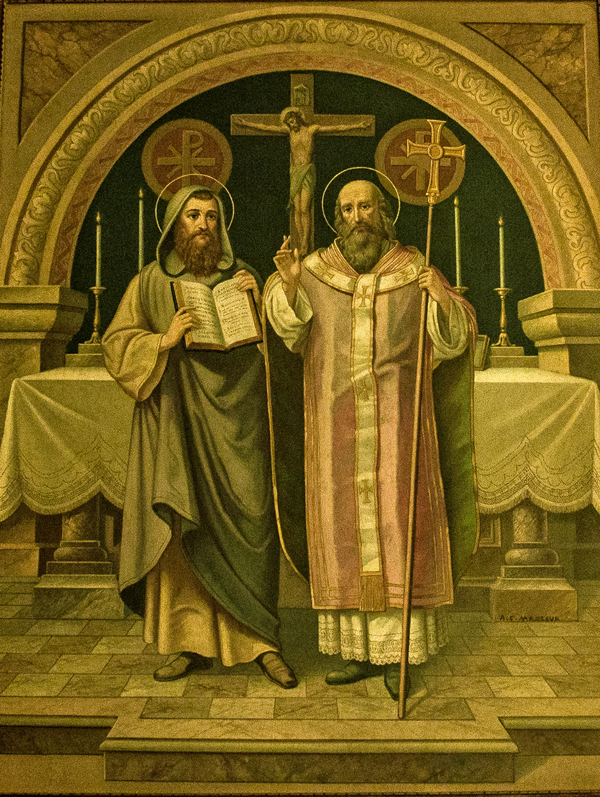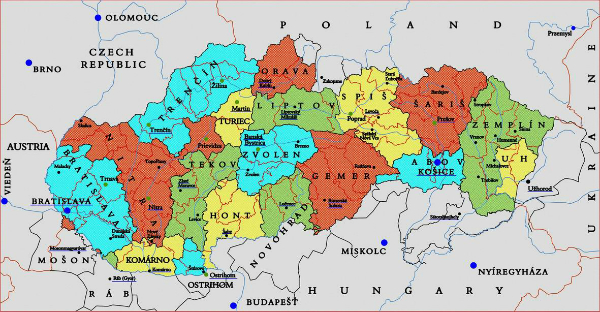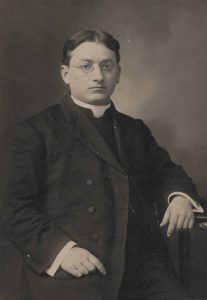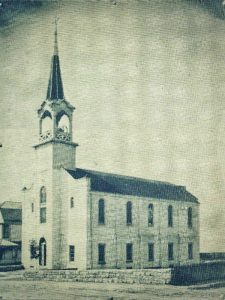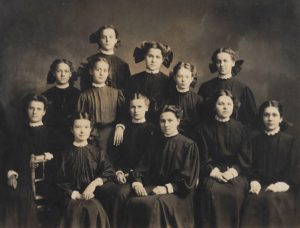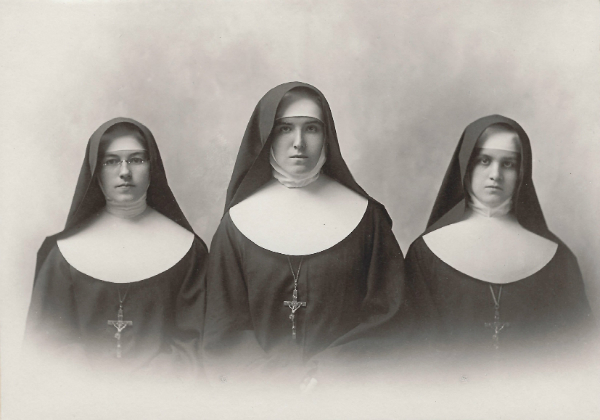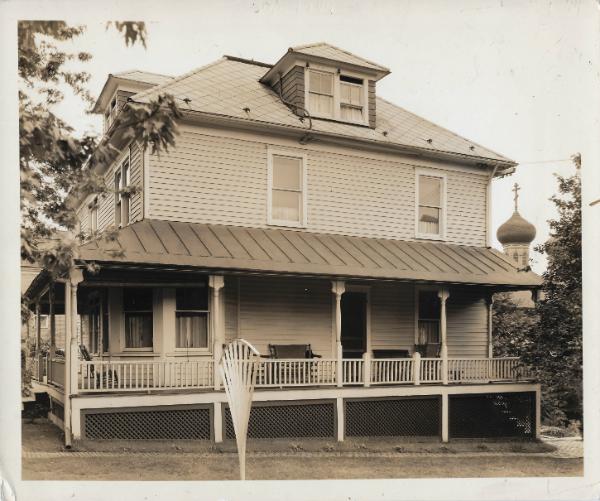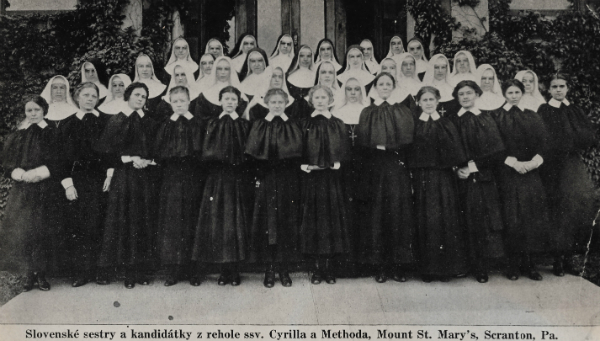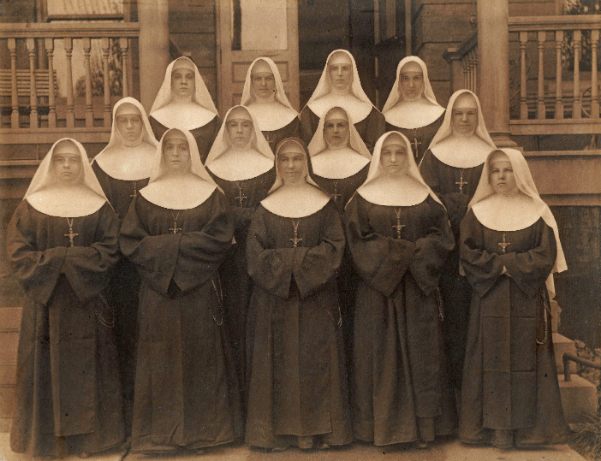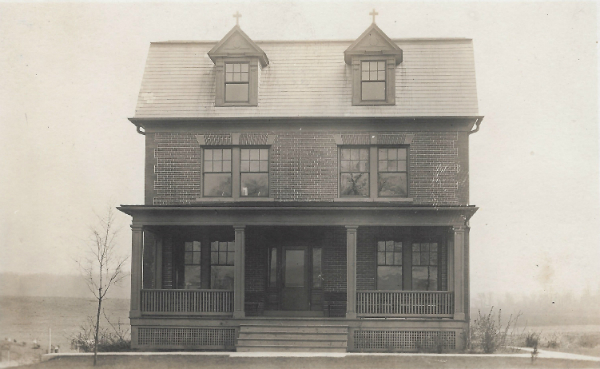Our Early History
Patron Saints Cyril and Methodius
Our history begins with the lives of our patron saints, Cyril and Methodius, brothers born in Thessalonica (present day Greece) approximately 1,200 years ago in the ninth century. They journeyed from Thessalonica to Great Moravia (Central Europe) in 863 after Prince Rastislav requested that Emperor Michael III send missionaries to evangelize the Slavic people. Because the Slavic people had no written language, Cyril devised the Glagolitic alphabet – the first alphabet used for Slavonic manuscripts that became Cyrillic script, and one still used by many languages today, including Russian.
During their mission trip, Cyril and Methodius brought with them Christianity and began translating into Slavonic the New Testament, many of the Psalms and the Liturgical Books. The brothers laid the foundation for written Slavic literature and the preservation of their culture. They wrote the first Slavic Civil Code used in Great Moravia and shared their faith there. They also trained native clergy and exercised authority in the spirit of service and humility. The brothers exemplified Christian unity, blending the theological insights and spirituality of Eastern and Western Christianity.
In 1980, Pope John Paul II proclaimed them co-patrons of Europe, a tribute to their influence on belief, written word and culture.
Slovak Heritage
Matthew Jankola, the founder of the Sisters of Saints Cyril and Methodius, was born in 1873 near Budapest, Hungary, to migrant laborers from Trstená, Slovakia. He immigrated to the United States and arrived in Baltimore as a 21-year-old seminarian on December 19, 1893. He was accepted at St. Bonaventure Seminary in Allegheny, New York, and was ordained January 13, 1895, by Bishop William O’Hara in Scranton, Pa. Father Jankola’s first assignment was pastor of Saint John the Baptist Parish in Pittston, Pa. Gifted in administration and leadership, he also ministered to more than 8,000 Slovaks scattered across seven other towns in the Wyoming Valley region of Pennsylvania.
While at Saint John the Baptist Parish, Jankola’s first task in Pittston was to build a larger church. He also supervised the building of two other churches: Sacred Heart in Wilkes-Barre and Holy Trinity in Swoyersville, Pa, and organized five other Slovak parishes in the Scranton Diocese. When there was no priest available, he ministered to the Slovaks in Binghamton, New York, 60 miles away. His missionary situation was like that of the pioneer priests of the early Church in America – he ministered to Slovaks who were widely scattered throughout the Wilkes-Barre/Scranton area and beyond. Father Jankola served as pastor of several other parishes before becoming the pastor of Saint Joseph’s Church, Hazelton. There he laid the foundation for a new religious congregation, the Sisters of Saints Cyril and Methodius.
Our Founding
Father Jankola’s dream as a young pastor was to organize a religious congregation of women to meet the educational and spiritual needs of children of Slovak immigrants who were rapidly arriving in Northeastern Pennsylvania. His goal was to preserve the Slovak faith and culture and provide both children and adults with a way to embrace their heritage.
In each of the parishes he served, Father Jankola expanded both spiritual and secular education for the children, and provided for the adults by offering evening classes in reading and writing, and also worked to meet the needs of immigrants applying for citizenship. He not only looked after the spiritual and educational needs of his parishioners, but also attended to social and cultural needs as well. He established confraternities and sodalities to bring people together in the parish and provided for cultural expression and development by forming parish choirs and drama clubs.
To further his dream of establishing a congregation of religious women to staff the parish schools, in 1903, he met with several Slovak immigrant priests to establish the Priests’ Treasury of Saint Anthony, which provided funding for the education of the first Sisters, who were mostly daughters of poor immigrants. Father Jankola and three other priests agreed to preach from the pulpit on vocations to consecrated life and to solicit funds to support the education of a new community of consecrated women. After Father Jankola preached a sermon acquainting parishioners with his plan, three women from his own parish, Saint Joseph in Hazleton, applied after Mass. Mary Mihalik, Mary Bartek and Mary Pauly applied, and were received as the first three postulants for the new religious congregation on January 6, 1903. The postulants were invited to Mount Saint Mary Seminary by Mother Mary Cyril Conway, General Superior of the Sisters, Servants of the Immaculate Heart of Mary (IHM), to complete their high school education and learn about religious life. They were received as novices July 26, 1906, and were given the names Sister Mary of the Assumption, Sister Mary Joseph and Sister Mary Emmanuel.
After the second reception of novices on April 13, 1908, Father Jankola met with officers of the Priests’ Treasury of Saint Anthony to draft a petition for the establishment of the new religious congregation – the Sisters of Saints Cyril and Methodius. This petition was brought to Rome and presented to Pope Pius X in 1909 and by August that year, Bishop Michael Hoban of Scranton returned from Rome with the news that the Holy Father gave approval for the establishment of the Congregation of the Sisters of Saints Cyril and Methodius. On September 11, 1909, the first Sisters made their public profession of vows and the Congregation was founded. Father Jankola joyfully exclaimed: “You are my joy, you are my crown, you are my glory.”
Our Mission Begins
The Sisters of Saints Cyril and Methodius expanded rapidly. From 1910-1913, young women interested in religious life were accepted at convents including Sacred Heart in Wilkes-Barre, Saint John the Baptist in Pittston, Holy Ghost in Olyphant and Saint Stephen’s in Plymouth, Pa. Personal sacrifice was the mortar that held the foundation of the congregation together. The mission was to preserve the faith and culture of the Slovak people by providing education to children.
The first three sisters immediately began teaching in parishes. In 1913, the First Catholic Slovak Union, Jednota, began constructing the Immaculate Conception Home, an orphanage in Middletown, Pa. The home would provide for the surviving children of their members who died in hazardous conditions working in mines and mills. With the support of the experienced Sisters, Servants of the Immaculate Heart of Mary, the Sisters of Saints Cyril and Methodius began serving at the newly built orphanage. After a decade at Mount Saint Mary’s in Scranton, the Novitiate of the young Sisters was transferred to Middletown in 1914, so sisters could serve children at the orphanage.
Mother Mary Mihalik was elected general Superior on July 12, 1915, and established the Motherhouse at Saint Stephen’s Convent in Plymouth. She resided and administered the Congregation there, until her health deteriorated and she was forced to transfer to Middletown, where she died on April 30, 1916 at the age of 29. After suffering a stroke, Father Jankola died just five days after Mother Mary on May 5, 1916. Prior to Mary’s death, Harrisburg’s Bishop John Shanahan died February 19, 1916, and had barely been acquainted with the Congregation and its mission.
Newly-appointed Mother M. Emmanuel Pauly helped carry the young community through the difficult time. She established the community’s strong bond with Bishop Philip Richard McDevitt and appealed to the Sisters of the Immaculate Heart (IHM) of Mary for help with the formation of Novices, who in turn sent Mother Monica, IHM, in August 1918.
The number of Sisters was growing, and so was the need for space.
Establishing Villa Sacred Heart
Searching for a place for the growing number of Sisters, Mother Emmanuel learned of a property for sale in Danville, Pa., in November 1918. Reverend Thomas F.X. Dougherty was pastor of Saint Joseph Church in Danville and was able to help the Sisters with information about the property. The estate consisted of a 44-room Italianate mansion, stables, barns, greenhouses, a farmhouse and a liveryman’s house on 187 acres of land. Known as “Castle Grove,” the mansion—a Tuscan villa—had been built in 1867 by John Grove, Sr. for his two sons, Michael and John Grove, Jr. After the death of the estate’s next owners, Caroline Grove Bennett and John Bennett, the estate was abandoned in 1905. After the end of World War I, John’s second wife listed the property for sale.
On June 7, 1919, the sale to the Congregation was made final. The estate had been abandoned for 14 years and needed a significant amount of attention. The Sisters and Novices moved to Danville knowing they had a great deal of work ahead of them but were overjoyed by a place to call their own. On August 28, the first Reception and Profession Ceremonies were hosted in the solarium of Villa Sacred Heart, the name given to the new house.
To support the Congregation’s mission to provide education, Mother Emmanuel and the Council prepared to open a school in the mansion. The first students under high school age arrived in September 1920. Named the First Catholic Slovak Girls’ High School and later Saint Cyril Academy, the first ten graduates received their diplomas on June 14, 1926. Enrollment for both elementary and secondary levels increased as the reputation for quality education became known. The Villa mansion was home to the Congregational administration and school faculty and the Novitiate, making expansion necessary.
Under the leadership of Mother M. Pius Yakubov, General Superior, ground for a new school was broken in June 1929, and the cornerstone was laid in September— just before the start of the Great Depression. Despite the world-wide economic downturn, construction of a Gothic style academy continued, thanks to the incredible generosity of supporters and trust in God. The new school opened in September 1931.
On August 27, 1934 the Congregation celebrated its 25th anniversary. The collection that day became seed money for the construction of a new chapel. Because it was built during the Great Depression and beginning of World War II, the chapel serves as a testament to thousands of people’s faith in God. The beautiful precious metals of the tabernacle, vaulted ceiling tiles, terrazzo floors and marble altar, baldachino and walls are a reminder of incredible generosity during a time of great economic strife. The chapel was dedicated by Cardinal Dennis Dougherty on October 17, 1939, and later declared a Minor Basilica in 1989.

